Oxford Movement Historical Theology Collection (10 vols.)
Digital Logos Edition
Overview
The Oxford Movement Historical Theology Collection brings together some of the most important titles to have stemmed from the Oxford Movement and the Tractarians. As historical documents, the ten volumes, all long out-of-print, play witness to one of the greatest debates in the Church of England since its split from the Roman Papacy. As works of theology, the volumes deliver edifying accounts of church history, apostolic succession, the nature of the Virgin Mary, the doctrine of the Eucharist, and many other issues pertinent to any era.
This collection focuses particularly on the works of Edward Pusey, leader of the Oxford Movement. Also included are three books by Darwell Stone and Charles Gore (Archbishop of Oxford) who helped assure by their writings that the work started by the Oxford Movement would continue into the 20th century. Moreover, the collection features an important work by J. B. Lightfoot, in which he clarifies some of his earlier claims that were contrary to the ancient traditions of the early undivided Church. This collection is valuable for students, clergymen, or anyone interested in church history, Eucharistic doctrine, or Anglicanism.
About the Oxford Movement
The Church of England’s secession away from the authority of the Roman Pope in the early sixteenth century caused a conflict between the Catholic and the Puritan elements in the English Church. The Catholics wished only to remove abuses added by the medieval church, whereas the Puritans wanted more radical changes along the lines of the continental reformation. By the end of the eighteenth century many of the Catholic elements had been stripped out of Anglicanism through the heavy influence of the Puritans.
In 1833 the Oxford Movement began a Catholic Revival within The Church of England. This movement began at Oxford University and included (among others) John Keble, John Henry Newman, Edward Bouverie Pusey, Isaac Williams, John Mason Neale and Charles Marriot. These men were often called the Tractarians, named so for their series of tracts (“Tracts for the Times”) promoting and defending the principles and theology of the movement. What they were arguing for was not a new religion, but rather a re-integration into Anglicanism of the Catholic faith of the Early Church Fathers – “the Faith once delivered to the Saints” (Jude 3). The Oxford Movement sought to establish the via media (the middle way) between the extremes of the abuses of the Medieval Papacy, and the stripped-down minimalist religion of Protestant Geneva.

- Excellent resource of church history, Eucharistic doctrine, and Anglicanism
- Five titles from Edward Pusey, leader of the Oxford Movement
- Ideal for students, clergymen, and laity
- Title: Oxford Movement Historical Theology Collection (10 vols.)
- Volumes: 10
- Pages: 4,178
This title is included in the following collections
You can save when you purchase this product as part of a collection.
Verbum 8 Ordinariate Silver Le...
$349.99$349.99Verbum 9 Ordinariate Silver Le...
$349.99$349.99Verbum 8 Ordinariate Gold Lega...
$849.99$849.99Verbum 9 Ordinariate Gold Lega...
$849.99$849.99
- $1,499.99
- $1,499.99
- $1,499.99
- $1,499.99
- $2,999.99
- $2,999.99
- $2,999.99
- $4,749.99$3,562.49
- $4,899.99$4,164.99
- $4,749.99
- $4,749.99
- $4,749.99
- $4,749.99
- $4,749.99
- $4,749.99
- $4,749.99
- $7,749.99
- $7,749.99
- $23,999.99$17,999.99
- $21,749.99
- $24,999.99
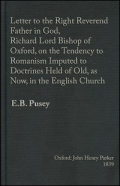
An artful explication of certain crucial points of the Oxford Movement. Written on the Feast of Saint Matthias, 1839, this volume (composed as a letter to the Bishop of Oxford) is a defense of the author against charges that he was teaching doctrines of Rome rather than adhering to the Formularies of the Church of England. Here, Pusey acknowledges the sufficiency of Holy Scripture for salvation, while making clear that this is not mutually exclusive with the rightful authority of the Church. He affirms the doctrine of Justification as put forth by the 39 Articles of Religion, while making clear the necessity of good works by man. He addresses the Sacraments at length, giving particular attention to the Eucharist, in which he clearly rejects the doctrine of Rome, and speaks to the various aspects of the ministry of Priests, which the Oxford Movement held in high regard.
Quoting widely from Scripture, Tracts for the Times, the Early Church Fathers, his own writings and other sources, Pusey gracefully defends the work of the Oxford Movement. He describes the movement as the via media (the middle way), and distinguishes it from the Church of Rome and radical reformers. The letter may be best summarized by the final words of the title given to an appendix: “Showing that to Oppose Ultra-Protestantism is Not to Favour Popery.”

The Doctrine of the Real Presence, As Contained in the Fathers, from the Death of S. John the Evangelist to the Fourth General Council, Vindicated, in Notes on A Sermon, “The Presence of Christ in the Holy Eucharist,” Preached A.D. 1853, Before the University of Oxford
- Author: E. B. Pusey
- Publisher: John Henry Parker
- Publication Date: 1855
- Pages: 722
Pusey’s renowned exposition of the doctrine of the Holy Eucharist. The basis for this volume is the 600 plus notes comprising the author’s sermon, “The Presence of Christ in the Holy Eucharist.” The sermon was preached in Christ Church to the faculty and students of Oxford University in 1853. It followed a two-year suspension from preaching altogether and a ten-year suspension from preaching of the Eucharist specifically, leveled against Pusey after a poorly received 1843 sermon on the Eucharist was denounced as “Romish.”
Pusey said in regards to this sermon: “The chief object of my sermon, ‘The Presence of Christ in the Holy Eucharist,’ was to maintain clearly and distinctly the doctrine of the Church of England upon one point, viz. ‘the Real Presence of the Body and Blood of our Saviour Christ under the form of bread and wine.’ This doctrine I endeavored to set forth with all the clearness that I could, out of Holy Scripture, and out of the teaching of the Fathers, as the nearest and best interpretation of the mind of God in Holy Scripture.”
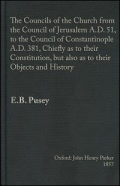
The Councils of the Church from the Council of Jerusalem A.D. 51, to the Council of Constantinople A.D. 381, Chiefly as to their Constitution, but also as to their Objects and History
- Author: E. B. Pusey
- Publisher: John Henry Parker
- Publication Date: 1857
- Pages: 353
A learned, albeit incomplete, account of the history of Councils of the Church, written chiefly to underline one vital message: “[M]atters of doctrine were always exclusively decided or attested by those whom the Apostles left to succeed to such portion of their office as uninspired men could discharge – the Bishops of the Universal Church.” However, the message remains unobtrusive within the fascinating narrative and historical aspects presented in the volume. And the book is far from being a mere compilation of learned lore without practical aspects.
Pusey here doesn’t merely focus on the commonly-held Ecumenical Councils, but also includes the Apostolic Council of Jerusalem, as well as the various Synods held in various places prior to the reign of Constantine. Of key focus in his work is the distinction, as established by the early undivided Church, between the roles of Bishops, Priests, Deacons, and the general laity. Also well-documented is the history of key doctrines and heresies, as defined by these early Councils.
Pusey began working on this history of the Councils of the Church in 1850, but found his work interrupted more than once, including the attack on him by others because of his sermons on the Real Presence of Christ in the Eucharist. The work was never finished, and thus does not go through the Council of Chalcedon (451 A.D.) as he had originally intended, but stops rather with the Council of Constantinople in 381 A.D.
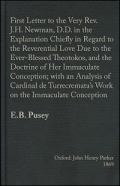
First Letter to the Very Rev. J. H. Newman, D. D. in Explanation Chiefly in Regard to the Reverential Love Due to the Ever-Blessed Theotokos, and the Doctrine of Her Immaculate Conception; with an Analysis of Cardinal de Turrecremata’s Work on the Immaculate Conception
- Author: E. B. Pusey
- Publisher: James Parker & Co.
- Publication Date: 1869
- Pages: 520
Sample pages: 1 | 2 | 3 | 4 | 5 | 6 | 7 | 8 | 9 | 10 | 11 | 11 | 12 | 13
The subject of debate in this particular volume (composed as a letter to John Henry Newman, former leading figure of the Oxford Movement) is the Virgin Mary and the doctrines put forth concerning her. Specifically, Pusey defends the ancient doctrine of her as Theotokos (“God-bearer”), as affirmed at the fourth Ecumenical Councils of the undivided Early Church, but also makes the case that the doctrine of the Immaculate Conception as put forth by Rome is theory and speculation, and as it may not be proved it ought not to be required of any man to be believed.
In 1845, after a long personal struggle over the validity of Anglican Orders, Newman converted to Roman Catholicism. From that point forward, most of the relationships that continued between Newman and his Oxford Movement peers were at best strained. This was particularly the case with Pusey. However, following a chance meeting, they began a dialogue in letters to one another, in which Newman tried to convert Pusey to the doctrines of Rome, and Pusey continued to resist such conversion and rather hold fast to his fight for the ancient Faith within Anglicanism. This volume is one such letter.
Well-researched and documented, Pusey’s work cites key figures on all sides of the debate, and appeals to the Fathers to support his argument. These include Augustine, Chrysostom, Ambrose, Alcuin, and John of Damascus. Also included is a section of analyses of various passages of Scripture, designed to build the case that the method of transmission of Original Sin remains a mystery.
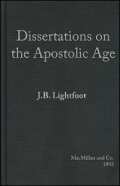
A collection of five dissertations by Dr. Lightfoot, reprinted from his commentaries on the Epistles of St. Paul. The dissertations include “The Brethren of the Lord,” “St. Paul and the Three,” “The Christian Ministry,” “St. Paul and Seneca,” and “The Essenes.” Each one expounds upon an important idea in Lightfoot’s theology.
In addition, “The Christian Ministry” ends with two appendices entitled “Additional Notes to the Dissertation Upon the Christian Ministry.” The first note gives Lightfoot’s justification for his final view on the genuineness of the Greek Epistles of Saints Ignatius and Polycarp, which was a departure from his earlier view of these same epistles. The second note clarifies his view on the three fold Christian Ministry. Each are helpful illuminations of something often ignored or missed by those students of Lightfoot, that being his clearer understanding of the doctrine of Apostolic Succession as central to the Oxford Movement.
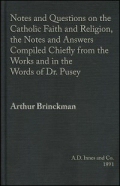
As Thomas Thellusson Carter insightfully observes in the preface, “After the heated controversy, there is generally felt to be comparative rest, and among opponents a disposition to be more forbearing and tolerant. It seems, therefore, that the time has come for attempting what is needed – the gathering up of the gains of the conflict, and what we trust will live on, as the testimony of the past generation to Anglo-Catholic truth.” These words were put forth at the precise moment in history when the Catholic Revival in Anglicanism, having begun in its fullest sense in the work of the Oxford Movement, had been victorious. The Catholic Faith, “as inherited and received by the Church of England,” was to remain in England.
In this important work, Brinckman draws extensively from the work and words of Edward B. Pusey. Through the work of Dr. Pusey, the Rev. Brinkman makes the case for Anglo-Catholicism. Here, he puts forth a system (albeit incomplete) of standard Anglo-Catholic beliefs, as well as what is essentially an instruction manual on Anglo-Catholic living and devotion.
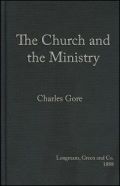
Published in 1888, this work by Archbishop Gore asserts that Apostolic Succession is and has always been an essential element of Christianity. The three fold ministry of Bishop, Priest, and Deacon was a central doctrine in the Oxford Movement. Along with this doctrine was the belief that Bishops were successors to the apostolic ministry. Well-researched and insightful, this volume appeals to both Scripture and early church history in its argumentation. It also addresses a number of objections to Apostolic Succession. As stated in the preface to the first edition: “[This book] maintains that Christianity is essentially the life of an actual visible society, and that at least one necessary link of connexion in this society is the apostolic succession of the ministry. In a word, this book claims on behalf of the apostolic succession that it must be reckoned with as a permanent and essential element of Christianity. It is an ‘apology’ for the principle of apostolic succession.”
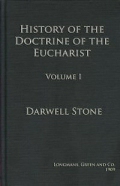
This large two-volume set is one of the most complete works on the Eucharsit, and is still recognized today as one of the most valuable. The first volume begins with an analysis of the relevant portions of the New Testament. Stone then systematically analyzes each time period in the history of the Church to the Reformation in the sixteenth century. In each period it provides quotes and analysis of the significant references to the Eucharist, both in the Eastern and Western Church.
The second volume begins with the Reformation and continues through the nineteenth century. The primary focus of this volume is the Church of England. However, it deals with other views of the Eucharist as they intersect the Church of England.
The Eucharist is one of the most important elements of the Christian religion and one of the most controversial. This two set volume gives a detail analysis of this important issue, covering two thousand years of church history in the process.
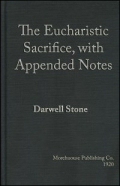
This great work by Stone, then Principal of Pusey House at Oxford University, is a compilation of six sermons preached by him at St. Paul’s Church, Knightsbridge, and St. Barnabas’ Church, Oxford, during the season of Lent in 1919. In it, Stone addresses the theological interconnections of Sacrifice, Resurrection, and Eucharist. He begins first with the sacrificial system of Old Testament, and even addresses Pagan sacrificial characteristics. He then moves forward into the Sacrifice as perfected by Christ through His Resurrection and as offered, based on His command, by the Church in the Eucharist.
These sermons are magnificent, and are compiled together into an invaluable cohesive theological work. Moreover, the 30 page “Appended Notes” included are an excellent collection of references, and by themselves make this volume worth having in every theological library.
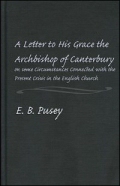
A Letter to His Grace The Archbishop of Canterbury on Some Circumstances Connected with the Present Crisis in the English Church
- Author: E. B. Pusey
- Publisher: John Henry Parker
- Publication Date: 1842
- Pages: 166
Dr. H. P. Liddon, contemporary and biographer of Pusey, speaking of this letter in which the Dr. Pusey lashes out at those who would place their partisan political agendas above the formularies of the Church of England, calls it “a document which, notwithstanding its studied respect and moderation, is the severest condemnation of an attempt to substitute the prejudices of a party for the formularies of the Church of England.”
The letter itself acknowledges the existence of some general tendency toward Rome. However, he maintains that this tendency has causes other than the Tracts. In order to discourage the tendencies by some Anglicans toward the Church of Rome, Pusey pleas that the negative language used to describe the Oxford writers by some of the Bishops be tempered.
The letter is one of the most striking of Pusey’s correspondences. Rather than losing itself in details, it is more concerned with the statement of principles. No previous task of the kind to which he set his hand in this case had been so delicate or so difficult. Never had he written with so keen a sense of urgent and increasing danger.
(from Who's Who in Christian History)
Pusey, Edward (1800–1882)
Leader in the Anglo–Catholic Oxford movement within the Church of England
Pusey was Regius Professor of Hebrew and canon of Christ Church at Oxford. He shared with other brilliant young Oxford conservatives concern about the rising tide of biblical and theological liberalism and the reform spirit rampant in Britain during the late 1820s and 1830s. He contributed to reviving a “dead” High Church orthodoxy by stimulating knowledge of the early church fathers and of non–Puritan Anglicans of the seventeenth century. Their teaching had been obscured, in his estimation, by Deism, Broad Church theological indifference, and the evangelicals’ concentration upon God’s work alone in justification and the experience of that. Pusey began to warn against the dangers of the new German theology, which he had studied firsthand. He began in late 1833 to contribute to the Tracts for the Times edited by John Henry Newman and to make the Tracts significant expressions of Anglo– Catholic teaching. He established a residence for theological students and a society for professors, tutors, and graduates in order to spread his principles. In 1836, he commenced editing translations of early Christian writers under the title The Library of the Fathers, which became a lifetime project, the last of the forty–eight volumes being published after his death. He was the first person of prominence to identify himself publicly with the movement, causing “Puseyism” to become the sometimes popular designation for it.
Because of an 1843 sermon, “The Holy Eucharist,” he was suspended two years from preaching at Oxford for the Romish views expressed, an event that contributed to the conversion of Newman and others to Roman Catholicism. Pusey, however, remained steadfastly within the Church of England. He had learned to bear much sorrow in his private life through strict discipline and such practices as the wearing of a hair shirt. Nor did he share Newman’s view that officials were to be obeyed absolutely. Pusey’s strength helped retain others. He was instrumental in 1845 in establishing an order of sisters in London. This was evidence of his personal charity and of new vitality among Anglo–Catholics in reaching the poor, as well as of the Church’s ability to accept Anglo–Catholic concepts. In 1846, he resumed his university preaching, taking up theologically where he had left off. Later, a new wave of liberalism in the church provided Pusey his final thrusts of public activity against the influence of Benjamin Jowett and biblical higher criticism.
Lightfoot, Joseph Barber (1828-1889)
Bishop of Durham; biblical scholar
Born in Liverpool, Lightfoot was educated at King Edward’s School, Birmingham, and Trinity College, Cambridge, where he became a fellow in 1852. He was ordained an Anglican priest in 1858 and taught classics in his college. In 1861 he became Hulsean professor of divinity. Lecturing mainly on the Epistles of Paul, he attracted large audiences. In 1870 he persuaded his friend B. F. Westcott to make himself available for the vacant regius professorship of divinity, to which Westcott was then elected. The two friends worked side by side, doing much to make critical study of the New Testament attractive.
Having refused the bishopric of Lichfield, Lightfoot accepted that of Durham in 1870. He gave himself wholeheartedly to his large diocese with its mines and ports. He organized a biennial diocesan conference, increased the number of full-time lay workers, started a church building fund, and traveled many miles to visit the parishes. Exhausted, he died in December 1889 and was buried in the chapel of Auckland Castle, the traditional home of the bishops of Durham.
Lightfoot’s scholarly output was immense. He was a leading member of the team of New Testament translators for the Revised Version. He filled his commentaries on Galatians (1865), Philippians (1868), and Colossians with Philemon (1875) with erudition. Likewise, his editions of the apostolic fathers (1869, 1885), especially the two volumes on Ignatius, were very important in their day. In his Leaders of the Northern Church (1890) he used his historical gifts to communicate at a more popular level. Lightfoot will be remembered, along with Westcott and Hort (his two companions), for providing the best in English biblical scholarship.
Gore, Charles (1853–1932)
Anglican bishop and theologian
Born at Wimbledon (England), Gore was educated at Harrow and at Oxford University, where he was elected a fellow of Trinity College in 1875. He became vice–principal of Cuddesdon Theological College in 1880, then served as first principal of Pusey House, Oxford (1884–1893). While there, he founded a religious order, the Community of the Resurrection, of which he remained head until 1901. After six years as a canon (clergyman) of Westminster Cathedral, he was appointed bishop of Worcester (1902).
Largely through Gore’s efforts, the new diocese of Birmingham was established. In 1905 he became its first bishop. Transferred to the see of Oxford in 1911, he served there until 1919, when he resigned. Settling in London, he devoted himself to writing and teaching: for example, from 1924 to 1928 he was dean of theology at King’s College, London.
Gore was a convinced High Churchman, emphasizing the Church of England’s Roman Catholic heritage. His book The Ministry of the Christian Church (1880; new edition, 1919, edited by C. H. Turner) became the standard exposition and defense of the principle of the apostolic succession. But he was an Anglo–Catholic of the most liberal kind who accepted the findings of evolutionary science and biblical criticism. This is portrayed, for example, in his essay, “The Holy Spirit and Inspiration,” in Lux Mundi (1889, a volume of essays that he edited).
Furthermore, Gore had a “permanently troubled conscience” concerning contemporary social and economic problems. A founder of the Christian Social Union (1889), in his book Christ and Society (1928) he emphasized the social implications of the gospel and made a strong plea for an unofficial interdenominational organization of Christian forces “to reassert the social meaning of Christianity.” In the view of W. R. Inge, a critic of Anglo–Catholicism, Gore was “one of the most powerful spiritual forces of (his) generation.”
Stone, Darwell (1859-1941) was a man of exceptional learning, spiritual insight and political shrewdness. An Anglo-Catholic theologian, he was arguably the greatest Principal of the Pusey House, having served there from 1909 to 1934. His best-known work is A History of the Doctrine of the Holy Eucharist, though he published many influential works of theology.
Reviews
2 ratings

Kevin Bratcher
6/12/2018

Father Andrew Johnson
10/25/2015